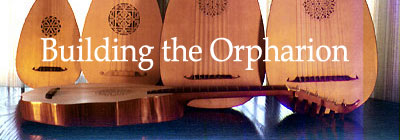Building the Orpharion
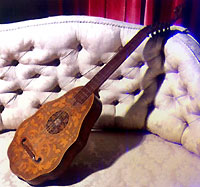 The orpharion and lute share the same tuning and playing techniques and their tablatures are identical. Anything that can be played on a six-course lute can be played on a six-course orpharion. At right is the orpharion built by John Rose about 1580, now in the possession of Lord Tollemache and kept in Helmingham Hall, Suffolk. The Orpharion was all the rage in England during the late 16th century. Many extant lute manuscripts indicate that the music is suitable "for lute or orpharion." It is remarkable that only two survive. The orpharion and lute share the same tuning and playing techniques and their tablatures are identical. Anything that can be played on a six-course lute can be played on a six-course orpharion. At right is the orpharion built by John Rose about 1580, now in the possession of Lord Tollemache and kept in Helmingham Hall, Suffolk. The Orpharion was all the rage in England during the late 16th century. Many extant lute manuscripts indicate that the music is suitable "for lute or orpharion." It is remarkable that only two survive.
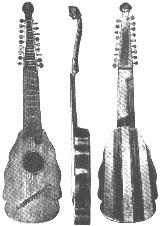 The Francis Palmer Orpharion, now housed in the Musikhistoriska Museum, Copenhagen, has nine courses. It was built during a period where lute music composition was at its highest point in England. It is one of only two surviving English-made instruments designed for that repertoire. This particular instrument has been the used as the basis for almost all modern orpharion reproductions. The Francis Palmer Orpharion, now housed in the Musikhistoriska Museum, Copenhagen, has nine courses. It was built during a period where lute music composition was at its highest point in England. It is one of only two surviving English-made instruments designed for that repertoire. This particular instrument has been the used as the basis for almost all modern orpharion reproductions.
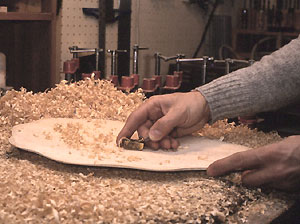 Most makers copy the orpharion by Francis Palmer rather than the one by John Rose. This is because the Rose orpharion poses some problems that will not produce a satisfactory instrument if it is copied exactly. It shows signs of restoration, including added bridge parts and improperly set pegs. Most makers copy the orpharion by Francis Palmer rather than the one by John Rose. This is because the Rose orpharion poses some problems that will not produce a satisfactory instrument if it is copied exactly. It shows signs of restoration, including added bridge parts and improperly set pegs.
To begin, I carved the back of the Orpharion from a two-piece block of figured maple, book-matched and joined at the center much like a violin back. The little curved brass violin plane makes quick work of removing the wood.
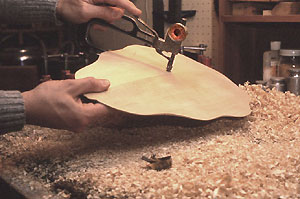 The back thickness is measured with a violin caliper to make it evenly thin along its entire surface. The back thickness is measured with a violin caliper to make it evenly thin along its entire surface.
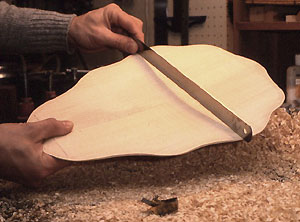 The final curvature and depth of the back can be seen here.
The edges are left flat for gluing onto the sides of the body later on. A flat area has been left for gluing onto the neck block as well. The final curvature and depth of the back can be seen here.
The edges are left flat for gluing onto the sides of the body later on. A flat area has been left for gluing onto the neck block as well.
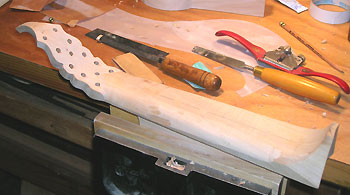 Before carving the neck from an expensive piece of well-aged figured maple, I carved a rough neck from a plain piece of soft wood in order to determine the exact shape of the neck and especially how the pegbox intersected the neck. By doing this, a problem with the peg angle was discovered. Before carving the neck from an expensive piece of well-aged figured maple, I carved a rough neck from a plain piece of soft wood in order to determine the exact shape of the neck and especially how the pegbox intersected the neck. By doing this, a problem with the peg angle was discovered.
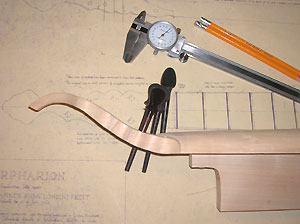 If the holes had been drilled exactly like the original instrument, the pegs would have hit each other because of the curvature of the pegbox. It is my guess that the instrument underwent incorrect restoration at some point, and new pegs were inserted from the wrong side. Citterns from this time period had their pegs inserted from the top, not from the back, and the Rose Orpharion was probably originally built like a cittern. The curvature of the pegbox would then make them splay outward in the opposite direction, giving enough clearance to tune the instrument. If the holes had been drilled exactly like the original instrument, the pegs would have hit each other because of the curvature of the pegbox. It is my guess that the instrument underwent incorrect restoration at some point, and new pegs were inserted from the wrong side. Citterns from this time period had their pegs inserted from the top, not from the back, and the Rose Orpharion was probably originally built like a cittern. The curvature of the pegbox would then make them splay outward in the opposite direction, giving enough clearance to tune the instrument.
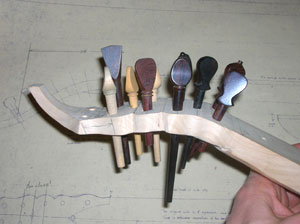 I decided to insert the pegs from the front. Problem solved. These are not the pegs I will use. I will eventually turn a matched set. I decided to insert the pegs from the front. Problem solved. These are not the pegs I will use. I will eventually turn a matched set.
The rest of this article will be finished in the coming weeks as I take more photos.
| 
